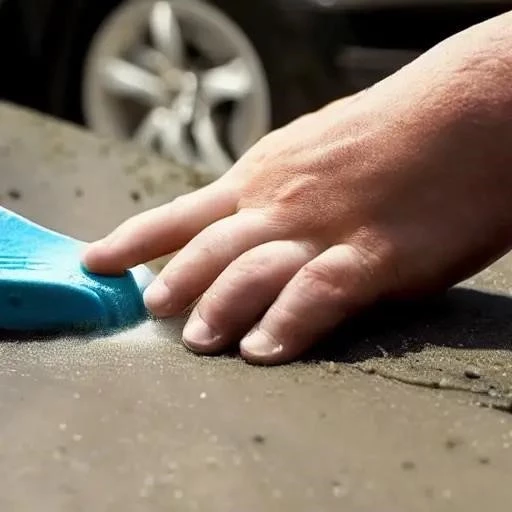
There are few sights more disheartening for a car owner than discovering an unsightly smudge or streak of foreign paint marring their vehicle’s pristine finish. Whether it’s the accidental caress of a freshly painted garage door, the insidious overspray from a nearby construction project, or a regrettable fender bender leaving a colorful memento, the immediate dread is palpable; Your heart sinks as you envision exorbitant body shop bills and days without your cherished ride. But what if I told you there’s a remarkably effective, often overlooked, and incredibly empowering path to restoring your car’s former glory, all from the comfort of your own driveway? This isn’t just about cleaning a stain; it’s about reclaiming your vehicle’s aesthetic integrity and, in the process, saving a substantial sum.
The good news, radiating with optimistic potential, is that many instances of unwanted paint transfer are surprisingly manageable for the diligent DIY enthusiast. Armed with the right knowledge, a few specialized tools, and a healthy dose of patience, you can tackle these automotive blemishes with confidence. Far from being an insurmountable challenge, removing extraneous paint can be a deeply satisfying endeavor, transforming a moment of despair into an opportunity for meticulous craftsmanship. By understanding the nature of the offending paint and the delicate chemistry of modern automotive finishes, individuals are increasingly empowered to become their own detailers, preserving both their vehicle’s value and their peace of mind. Let’s delve into the methods that promise to transform your car’s appearance, ensuring it gleams as brilliantly as the day you first drove it home.
Essential Insights: Navigating Paint Removal Successfully
Understanding the nuances of paint removal is paramount for achieving professional results without damaging your vehicle’s clear coat. This table provides crucial information for anyone embarking on this restorative journey.
| Category | Key Information |
|---|---|
| Types of Unwanted Paint |
|
| Common Removal Methods |
|
| Key Safety Precautions |
|
| Tools & Materials Needed |
|
| When to Seek Professional Help |
|
| Further Reference | AutoGeek.net ⏤ Car Care Resources |
The Arsenal of Restoration: Tools and Techniques
Embarking on this restorative journey begins with a fundamental understanding of your adversary: the unwanted paint. Is it a fresh, superficial splatter, or has it had time to bond fiercely with your clear coat, becoming a stubborn, embedded imperfection? This critical distinction dictates your approach. For the most common culprits, such as light overspray or minor transfer, the humble detailing clay bar emerges as an incredibly effective, yet remarkably gentle, first line of defense. Imagine it as a microscopic magnet, skillfully lifting contaminants without resorting to abrasive force. Professional detailers, often extolling its virtues, consider claying an indispensable step in preparing any vehicle for advanced paint correction. “A proper clay bar treatment,” notes renowned automotive care expert Mike Phillips, “is the foundation for truly brilliant paint. It safely decontaminates the surface, allowing subsequent polishing and waxing to achieve their maximum potential.”
When faced with more tenacious paint transfer, perhaps from a minor parking lot mishap, a targeted approach involving specialized automotive paint removers or solvents becomes necessary. These aren’t your average household paint thinners, which could irrevocably damage your car’s delicate clear coat. Instead, these professional-grade formulations are meticulously engineered to dissolve foreign paint while remaining largely inert to factory-applied finishes. The key here, as always, is judicious application and rigorous testing on an inconspicuous area, like the lower rocker panel or inside the door jamb. Applying the solvent sparingly with a clean microfibre cloth, allowing it to dwell for only moments before gently wiping away, can yield astonishing results, dissolving the offending layer of paint with minimal effort and maximal safety. Following this, a gentle wash and a protective wax or sealant are essential steps, safeguarding your newly liberated finish.
Beyond Removal: Polishing and Protection
Even after successfully removing the majority of the unwanted paint, a faint haze or subtle marring might remain, especially if the foreign paint was deeply embedded or required more vigorous methods. This is where the art of paint polishing enters the scene, elevating your DIY efforts to a professional standard. A fine polishing compound, applied either by hand or, for the more ambitious, with a dual-action orbital polisher, can meticulously refine the clear coat, erasing minor imperfections and restoring unparalleled gloss. Think of it as gently exfoliating the car’s skin, revealing the vibrant, unblemished layer beneath. Leading detailing brands like Meguiar’s and Chemical Guys offer an array of compounds tailored for various levels of paint correction, each designed to achieve a mirror-like finish, reflecting light with breathtaking clarity.
Crucially, the final act in this automotive restoration drama is protection. Having invested your time and effort into perfecting your car’s surface, shielding it from future contaminants and environmental assaults is non-negotiable. A high-quality carnauba wax, a synthetic paint sealant, or even an advanced ceramic coating will provide a sacrificial barrier, repelling water, UV rays, and preventing new paint transfers from bonding aggressively. This protective layer not only preserves your hard work but also enhances the paint’s depth and shine, making subsequent cleanings significantly easier. It’s a forward-looking strategy, ensuring that the vibrancy you’ve painstakingly restored endures, maintaining your vehicle’s aesthetic appeal for months, even years, to come.
When to Call the Experts
While the DIY approach offers immense satisfaction and financial savings, there are indeed scenarios where professional intervention is not just advisable, but imperative. If the foreign paint is accompanied by deep scratches that have penetrated beyond the clear coat into the color layer, or if the affected area is extensive and baked-on, indicating a chemical bond that DIY methods might struggle to break safely, then a reputable body shop or professional detailer is your best recourse. They possess the specialized equipment, advanced compounds, and seasoned expertise to handle complex paint corrections, ensuring a seamless, factory-quality repair without risking further damage. Recognizing the limits of your own capabilities is a mark of true automotive stewardship, preventing potential DIY mishaps from escalating into costly professional repairs.
Embrace the Journey: Empowering Your Automotive Care
The journey of removing paint off a car is more than just a chore; it’s an opportunity to forge a deeper connection with your vehicle, transforming it through meticulous care. By embracing these accessible, yet incredibly effective, techniques, you not only save money but also cultivate a profound sense of accomplishment. The gleaming reflection staring back at you from your car’s rejuvenated surface isn’t merely a testament to a clean finish; it’s a mirror reflecting your dedication, ingenuity, and the powerful satisfaction of a job expertly done. So, the next time unwanted paint threatens your car’s allure, remember: you are equipped with the knowledge and tools to confidently restore its brilliance, driving forward with pride and an impeccably maintained machine.
